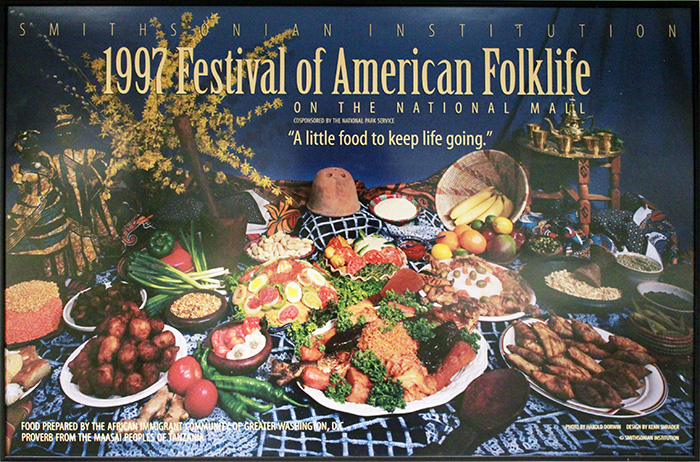Here at the Smithsonian Center for Folklife and Cultural Heritage, we have a meta-foodways tradition. Whenever a staff member travels to an interesting place—whether foreign or to their hometown, it is customary to bring back a traditional food item to share with the office. News of a shared treat generally comes by way of an inter-office email: “The Original Derby Pie brought back from my home state of Kentucky, now in the kitchen while supplies last,” it might read, or “Back from Jakarta, I offer Bangkit Jaghe (a spicy ginger cookie) from Macassar in South Sulawesi.” We’ve had kiffles from Hungary, ampelmännchen gummis from East Germany, and a favorite: peanut butter-filled taffy chews from a third-generation Bakersfield, California, confectionery company.
This office tradition is a way of celebrating unique foodways from around the globe, but it also serves as our own foodways tradition that fosters camaraderie, sharing, and celebration within our workplace community. But just what does “foodways” mean, and why, as an office of folklorists, anthropologists, ethnomusicologists, archivists, etc. are we particularly interested in it?
Professor Warren Belasco, a forerunner in the field of food studies, says, “Food identifies who we are, where we came from, and what we want to be.” Food affirms, makes visible, and facilitates connections to identity, family, culture, religion, and each other. It brings people together, a centerpiece for social and cultural interaction, not only in the food item itself, but in the process or ritual of preparation and consumption. All of these are themes that folklorists and anthropologists are particularly interested in, and food is often paired with other forms of cultural expression like music—the stuff of ethnomusicologists. It also is visible in cultural documents and records like recipes, cookbooks, menus, and material objects that archivists are concerned with cataloging and preserving.
But something particularly unique about food as a cultural expression is that it can be an entry point to those spaces and people who are often hidden— unseen or unheard. To study and share food is to be allowed access to private spheres and intimate domestic family spaces, granted a place at a kitchen table, a stovetop, or a hearth. Food is often a prominent form of cultural expression for women and underrepresented individuals. It can manifest as a powerful communication of identity, culture, and knowledge for those rarely given the chance to speak in other forms. As group of people invested in folklife and cultural heritage, that access is particularly important and valuable.
In the following articles, we’ll get a glimpse into the holiday foodways traditions and experiences of some of our staff. In his description of a Polish wigilia, or Christmas Eve supper, curator Jim Deutsch explores how foodways allow for a way to share in a culture not your own. Curator Betty Belanus describes how the recreation of a traditional Welsh Christmas in July at the Smithsonian Folklife Festival became its own new form of celebration, and editor Elisa Hough muses on expressing her Filipino identity through a family culinary custom while uncovering how the malleability of traditions doesn’t diminish but rather affirms a personal connection to them.
Consider this our way of sharing a bit of our Center’s foodways, both collective and individual, with you, and we hope you’ll share some of your own in the comment section below.
Emily Hilliard is the marketing assistant at Smithsonian Folkways. She writes the pie blog Nothing in the House and is a faithful believer in butter.


